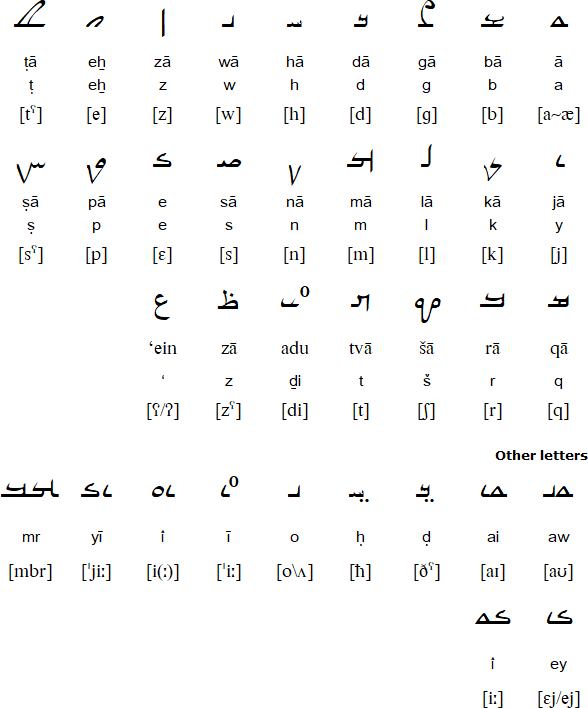Neo-Mandaic is an Aramaic language spoken by 300-500 people in Iran and among the Mandaean diaspora. It is more conservative than other Neo-Aramaic languages, though has been influenced by Arabic and Persian. It is a modern descendent of Classical Mandaic, the liturgical language of the Mandaean religion in Iran and Iraq. There are two dialects: Ahvāz and Khorramshahr, which are mutually intelligible.
Neo-Mandaic is rarely written, but when it is a version of the classical Mandaic script is used.

Download an alphabet chart for Neo-Mandaic (Excel)
Information about Neo-Mandaic provided by Wolfram Siegel (Word doc, in German)
Information about Neo-Mandaic
http://en.wikipedia.org/wiki/Neo-Mandaic
http://www.iranicaonline.org/articles/mandaeans_6_neomandaic
http://mandaic.org
http://www.academia.edu/1416132/41._Neo-Mandaic
Aramaic, Assyrian / Neo-Assyrian, Chaldean Neo-Aramaic, Neo-Mandaic, Suriyani Malayalam, Turoyo, Western Neo-Aramaic
Akkadian, Amharic, Arabic (Algerian), Arabic (Bedawi), Arabic (Chadian), Arabic (Egyptian), Arabic (Gulf), Arabic (Hassaniya), Arabic (Hejazi), Arabic (Lebanese), Arabic (Modern Standard), Arabic (Moroccan), Arabic (Najdi), Arabic (Sudanese), Arabic (Syrian), Aramaic, Argobba, Assyrian / Neo-Assyrian, Canaanite, Chaha, Chaldean Neo-Aramaic, Ge'ez, Hadhramautic, Harari, Hebrew, Himyaritic, Jewish Neo-Aramaic, Maltese, Mandaic, Nabataean, Neo-Mandaic, Phoenician, Punic, Qatabanic, Sabaean, Sabaic, Silt'e, Syriac, Tigre, Tigrinya, Turoyo, Ugaritic, Western Neo-Aramaic
Page last modified: 23.04.21
[top]
You can support this site by Buying Me A Coffee, and if you like what you see on this page, you can use the buttons below to share it with people you know.

If you like this site and find it useful, you can support it by making a donation via PayPal or Patreon, or by contributing in other ways. Omniglot is how I make my living.
Note: all links on this site to Amazon.com, Amazon.co.uk
and Amazon.fr
are affiliate links. This means I earn a commission if you click on any of them and buy something. So by clicking on these links you can help to support this site.
[top]